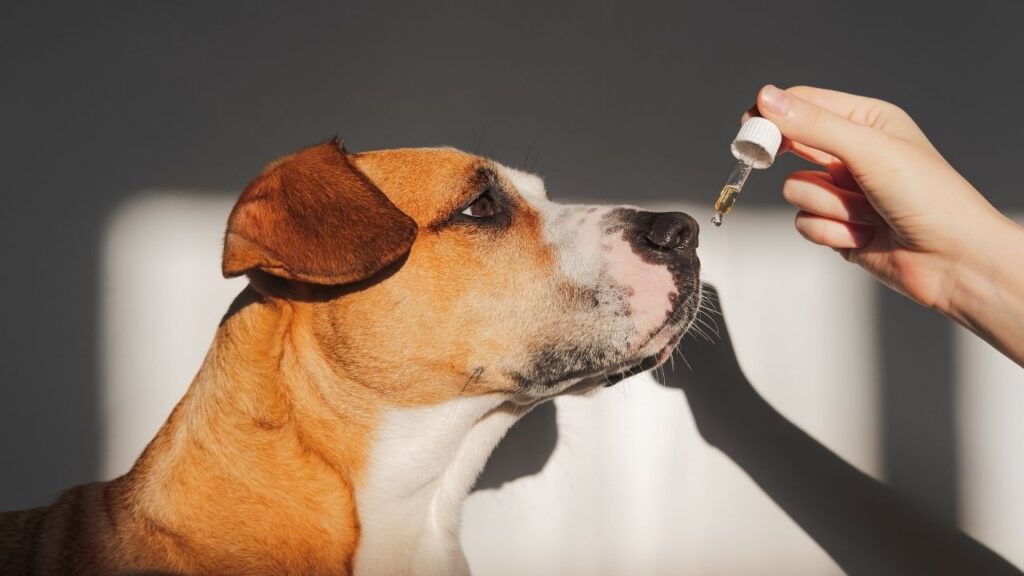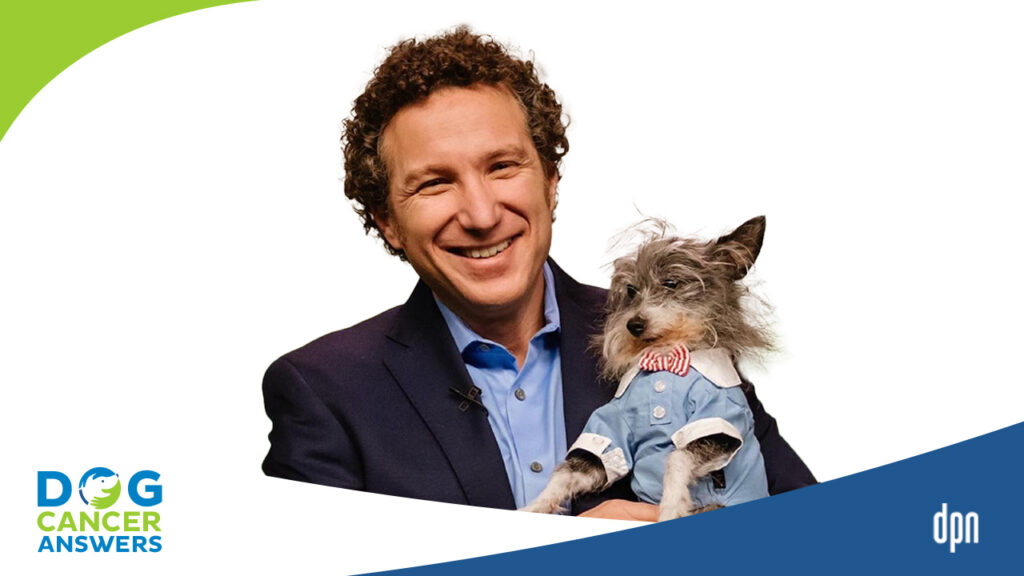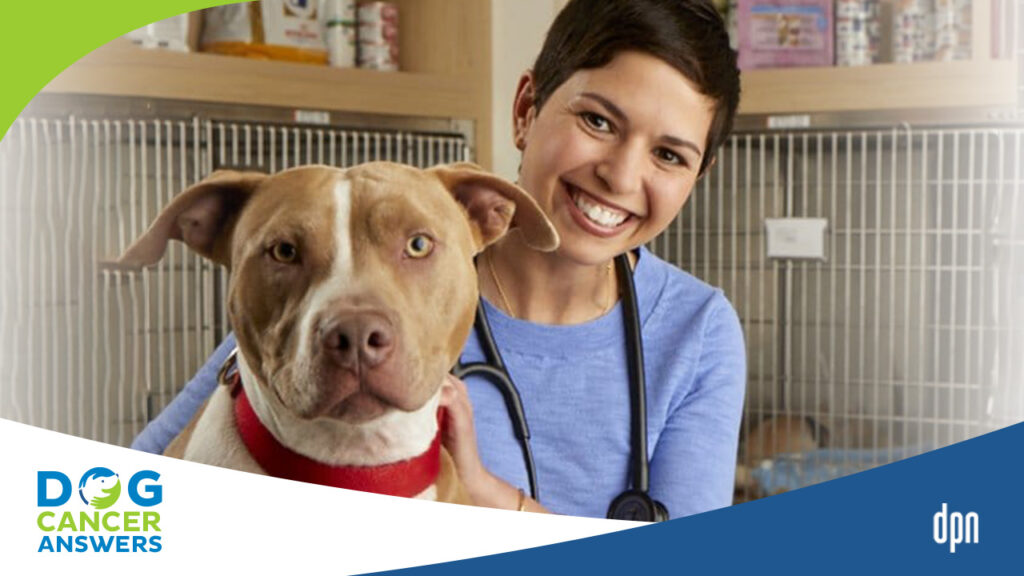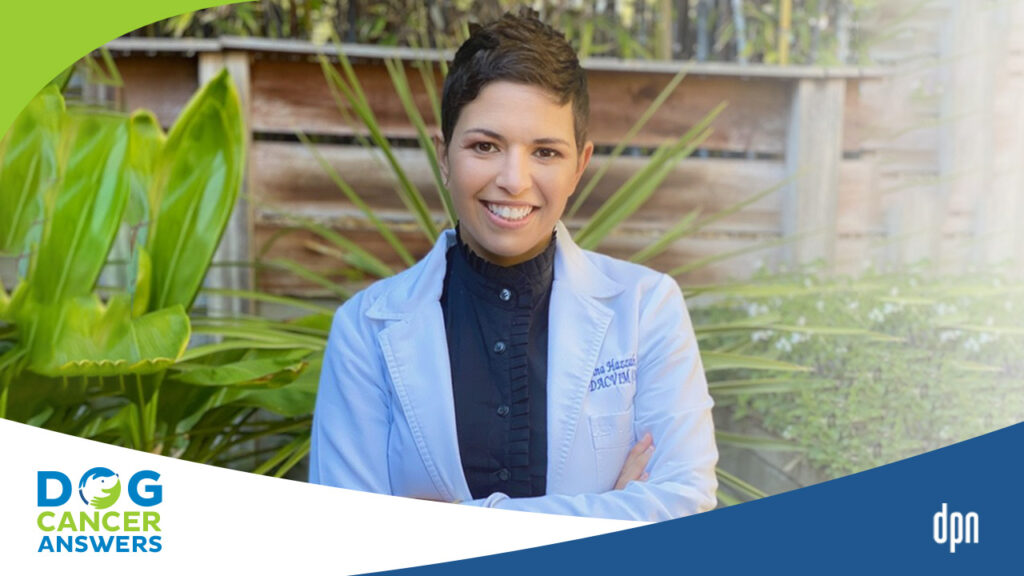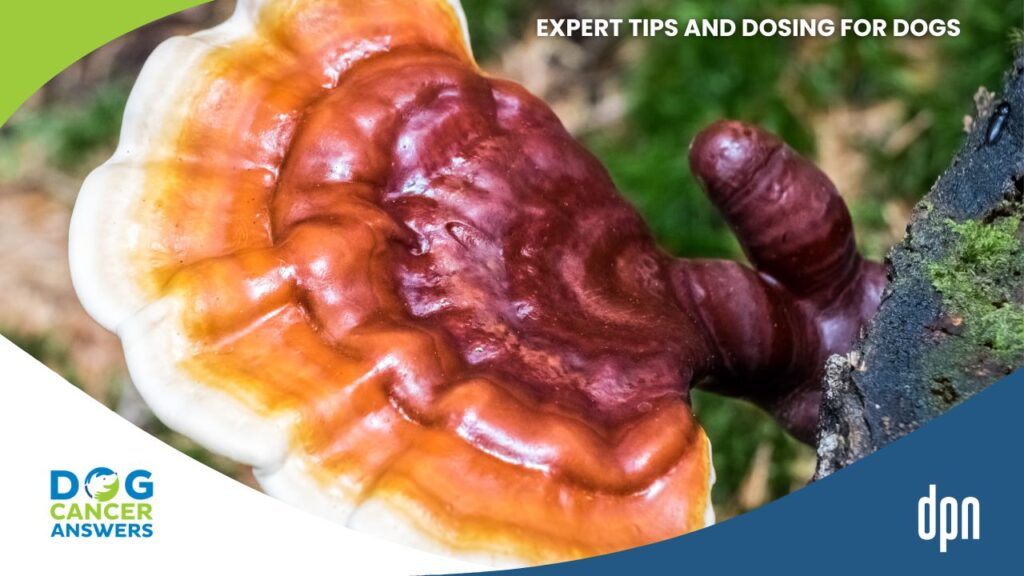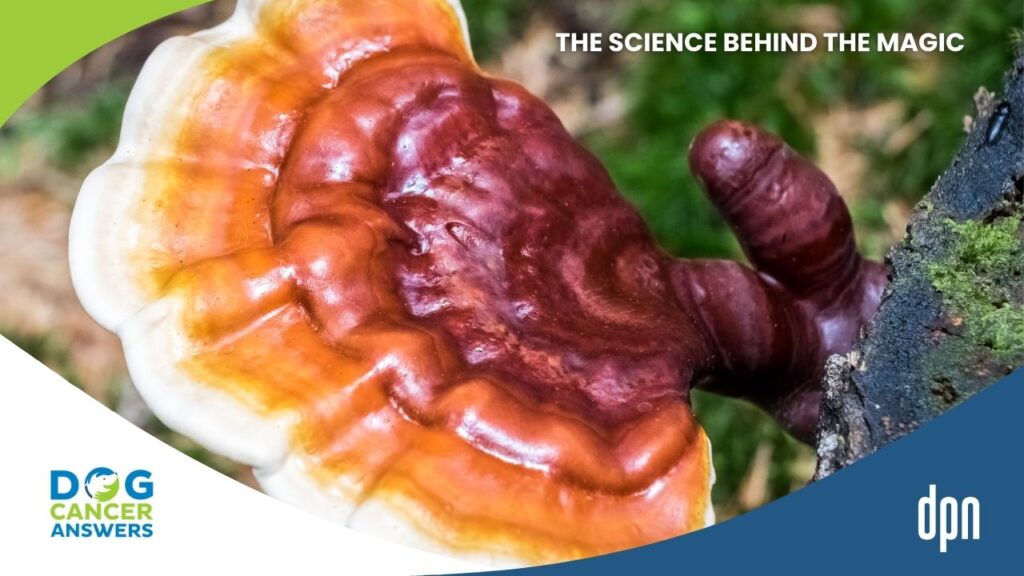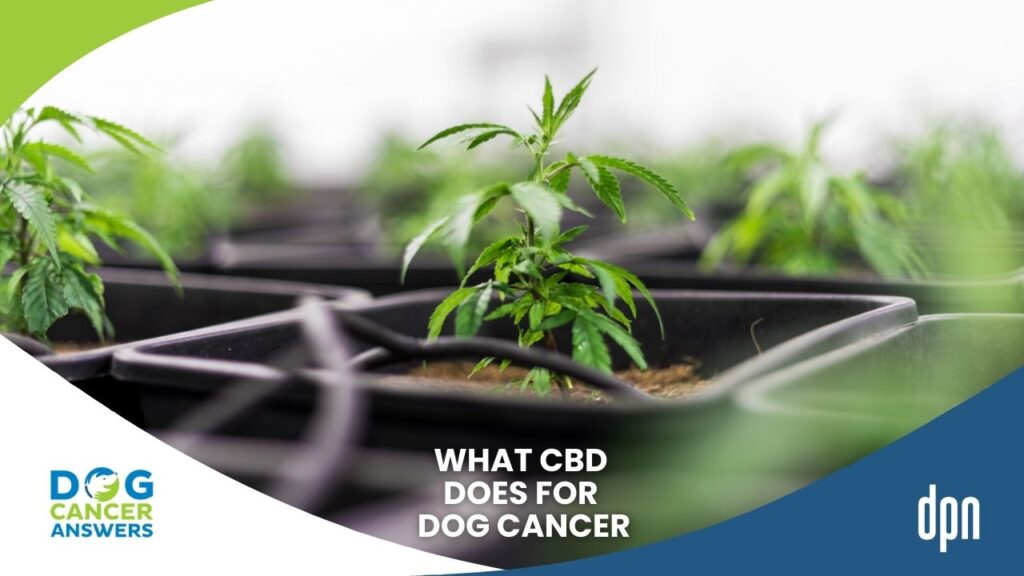[00:00:00] >> Kate Basedow: So both marijuana and hemp refer to a cannabis plant. So you’ve got cannabis as the overarching name for the plant, and then it can be divided into marijuana or hemp, which is based on the THC content of the plant.
[00:00:15] >> Announcer: Welcome to Dog Cancer Answers, where we help you help your dog with cancer.
[00:00:22] >> Molly Jacobson: Hello, friend. I’m Molly Jacobson Today on Dog Cancer Answers, we’re going to give you kind of a brief orientation to CBD and cannabis terminology. That’s because we recently had an amazing talk with Dr. Narda Robinson about CBD and cannabis, and you’ll be hearing that talk over the next couple of weeks. And this is such an incredibly exciting, emerging area of veterinary medicine, but it can get confusing.
So today we’re going to break down many of the words and phrases and chemical compounds that get thrown around so that you can fully appreciate the conversation with Dr. Narda and feel confident when reading about this amazing plant. To help me get through the nuances of these terms, we’re joined by our producer Kate Basedow. Kate is a veterinary technician and does a lot of behind the scenes work on the show and also on our website, dogcancer.com.
So Kate, what have you learned? You’ve put together a little dictionary. Let’s, let’s go through it.
[00:01:21] >> Kate Basedow: Yeah, I have learned quite a lot ’cause there’s so many terms involved with cannabis and its use in dogs and humans and in choosing a product that all sound slightly the same but are different. And sometimes the differences are major and have serious impacts either potentially for your dog’s health or for legality’s sake.
[00:01:44] >> Molly Jacobson: Right. Because the caveat is that at the federal level, we are still Schedule One for cannabis, for marijuana plants. The legality of things is going to be gray. Anybody listening to this, depending on what locality you’re in and what state you’re in, might have a different perspective, right?
[00:02:02] >> Kate Basedow: Yeah.
[00:02:03] >> Molly Jacobson: Almost everybody, I think, can get a CBD product at this time, but not everybody can get a full spectrum. Not everybody’s veterinarian is able to speak about it at all, there are some states where you can lose your license just for saying the words CBD or cannabis. And there are other states where you’re free to prescribe. So.
[00:02:25] >> Kate Basedow: Yeah.
[00:02:25] >> Molly Jacobson: It’s a, yeah, depending on where you are, you may or may not be able to have frank and direct discussions, so we just thought we’d lay out sort of the high level view of the words that you might be able to use with your veterinarian, or you might be able to read about online and see if they can help your dog.
[00:02:43] >> Kate Basedow: Yeah. Today we’re not wandering into any of the legalities or medical benefits or debates about medical benefits. Today we’re just sticking with cold hard definitions.
[00:02:54] >> Molly Jacobson: Right.
[00:02:54] >> Kate Basedow: Which as an English major I love.
[00:02:57] >> Molly Jacobson: Yeah. Right. And we have shows with Dr. Dressler about the legality, you know, things, we have lots of shows with veterinarians who use cannabis in their practices, and we’ll put links in the show notes to those so you can learn more about that.
But let’s just start with some basic terms. Cannabis. What’s cannabis, Kate?
[00:03:16] >> Kate Basedow: So cannabis is the plant, and it’s the plant that has caused all the buzz and drama and hubbub over the years. The cannabis plant has many chemical compounds which have been explored both for their medicinal properties and for recreational use.
And there’s still some debate about whether there’s just one single species of cannabis with a variety of cultivars, or if there are multiple different species and then with different cultivars in between them. But the basic plant that everyone talks about is cannabis, and that’s kind of the overarching term for the plant that we get all of these different chemical compounds from. And those chemical compounds are called cannabinoids.
So cannab, obviously connects back to the cannabis plant, and then -oid, from that plant. And that term cannabinoids covers all of the different chemical compounds that you can isolate from the cannabis plant.
[00:04:20] >> Molly Jacobson: And there are hundreds of those.
[00:04:21] >> Kate Basedow: Oh yeah, tons.
[00:04:23] >> Molly Jacobson: It’s not just, like we say CBD, but there’s so, that, that’s a very, very, very, very broad category. There’s lots of different little compounds that fit that description. Am I right?
[00:04:37] >> Kate Basedow: Oh yeah. Terpenes and phytocannabinoids and, as well as, so CBD and THC are the two that you hear about the most, but there’s also CBG, CBN, I think there’s a CBA, and lots and lots of other things. ‘Cause plants are not a single thing. There’s a lot that goes into making a single plant.
[00:05:00] >> Molly Jacobson: Right. There’s a lot of different little chemicals, sometimes called phytochemicals, phyto for plant. And I think one of the hard things is like when you talk about cannabis and you talk about the whole plant, you can sort of imagine like, oh, there’s lots of things in a plant. Like just go to an oak tree, and you can tell there’s a lot of things in that that make up that oak tree. There’s a lot of different parts and there’s a lot of different chemicals that are making up all of those different parts.
Same is true with cannabis. But the ones that we’re most interested in for their therapeutic value that we know the most about are CBD and THC at this point. I think we’re gonna find out more in the future if we get this plant off Schedule One.
[00:05:43] >> Kate Basedow: Yeah.
[00:05:44] >> Molly Jacobson: Start to really, yeah, dig in. So what’s CBD?
[00:05:47] >> Kate Basedow: So, CBD stands for cannabidiol, and that’s the primary compound that does not give hallucinogenic effects, but does have calming effects. And then THC is Delta-9-tetrahydrocannabinol. So you can see why everyone abbreviates it, because that’s a-
[00:06:06] >> Molly Jacobson: Yeah.
[00:06:07] >> Kate Basedow: That’s a nightmare of a mouthful. THC.
[00:06:10] >> Molly Jacobson: Tetrahydro.
[00:06:12] >> Kate Basedow: Cannabinol.
[00:06:13] >> Molly Jacobson: Cannabinol. Okay. Right. THC.
[00:06:16] >> Kate Basedow: And we will have all this written down in the show notes as well.
[00:06:19] >> Molly Jacobson: Okay.
[00:06:20] >> Kate Basedow: And THC does have psychoactive effects and also can cause toxicity in dogs. CBD is safe. THC, depending on the dose and the size of the dog, can cause toxicity and cause problems.
[00:06:35] >> Molly Jacobson: Okay. And the CBD is, to put it really simply, is the compound that sort of makes you feel relaxed, kind of cool, kind of chill. And the THC is the one that makes you think there’s other things going on in the world than what the human mind normally sees.
[00:06:49] >> Kate Basedow: Yeah. And obviously everything is dose dependent. And-
[00:06:53] >> Molly Jacobson: Right.
[00:06:53] >> Kate Basedow: Also product dependent, but-
[00:06:55] >> Molly Jacobson: And product dependent. Right.
[00:06:57] >> Kate Basedow: That’s a, that’s a discussion for another day.
[00:06:59] >> Molly Jacobson: Yeah. We’re gonna let Narda Robinson talk about that in the next couple episodes in this series. Okay. So the bottom line is THC, we need to have the dose carefully considered. And CBD, we also need to have the dose carefully considered, but it’s not considered a toxic compound for dogs.
[00:07:20] >> Kate Basedow: Yeah. Much safer.
[00:07:21] >> Molly Jacobson: Okay. What about the difference – because I know a lot of people will say, well, it’s not marijuana, it’s hemp. Like this is something that you hear in Hawaii a lot where we sort of have legalized marijuana, but only if you’re, if it’s for medical use and if you have a prescription, da da da da da da da. But then people will say, well, no, no, no, I’m taking a hemp product. So talk about the difference between marijuana and hemp.
[00:07:47] >> Kate Basedow: So both marijuana and hemp refer to a cannabis plant. So you’ve got cannabis as the overarching name for the plant, and then it can be divided into marijuana or hemp, which is based on the THC content of the plant.
[00:08:02] >> Molly Jacobson: Ah. That’s the only distinction.
[00:08:04] >> Kate Basedow: Yep.
[00:08:05] >> Molly Jacobson: Okay.
[00:08:05] >> Kate Basedow: That’s the difference. And marijuana just culturally over the years has developed more of a connotation of being related to recreational drug use. So a lot of veterinary and medical professionals prefer using the phrase "high THC cannabis" instead of "marijuana" to emphasize that they’re looking at it for medical reasons, not just for fun and to get high.
[00:08:30] >> Molly Jacobson: Oh, that’s really interesting. So you’re not probably gonna hear your veterinarian talk about marijuana, but you might hear them talk about high THC cannabis, but it’s the same plant.
[00:08:40] >> Kate Basedow: Yeah. And I got that tidbit from Dr. Trina Hazzah’s, one of her published papers on cannabis in veterinary medicine.
[00:08:48] >> Molly Jacobson: Okay.
[00:08:49] >> Kate Basedow: So that makes a lot of sense ’cause you’ve got so much stigma around the word marijuana. So they’re trying to kind of separate and distinguish it that way.
[00:08:59] >> Molly Jacobson: Right. Say we’re not thinking of this as the recreational drug. We’re thinking of this as a plant that has medicinal properties.
[00:09:05] >> Kate Basedow: Yeah.
[00:09:06] >> Molly Jacobson: Okay. Well that’s good. And we’ll put a link to Dr. Hazzah’s paper in the show notes as well.
[00:09:10] >> Kate Basedow: Yes.
[00:09:10] >> Molly Jacobson: Yes. Okay, great. So it’s really just the THC content. So how much THC, what’s the magic number?
[00:09:19] >> Kate Basedow: The magic number is 0.3% THC.
[00:09:23] >> Molly Jacobson: That seems very, very small to me.
[00:09:26] >> Kate Basedow: It seems low to me too, but then again, I mean some things it only takes a little to do a lot of damage.
[00:09:32] >> Molly Jacobson: Right.
[00:09:33] >> Kate Basedow: Like you look at even something like xylitol, the artificial sweetener in chewing gum, it only takes a very tiny amount of that to cause very serious problems for dogs and even death. So with anything, the dose makes the poison, right?
[00:09:50] >> Molly Jacobson: Right.
[00:09:50] >> Kate Basedow: And also, different things have different tolerance levels for different species. So a number that sounds low to us based on other things in our lives and just-
[00:10:01] >> Molly Jacobson: Right.
[00:10:01] >> Kate Basedow: -our experiences with numbers in general, the number itself alone doesn’t necessarily mean much. It’s in the context of the chemicals involved and the species involved.
[00:10:13] >> Molly Jacobson: Okay. That makes sense. That makes sense. Yeah. Not that I really know what a high THC level is anyway, personally.
[00:10:20] >> Kate Basedow: Right.
[00:10:20] >> Molly Jacobson: I’m just saying 0.3% seems low, but yeah, the dose makes the poison and how much does it take, you know, to, yeah. Poison doesn’t have to be – if you think of a spy movie, they have a little tiny pill and they take one little tiny pill.
[00:10:35] >> Kate Basedow: Yeah.
[00:10:35] >> Molly Jacobson: And they’re done. When they’re given that poison pill, it doesn’t take much typically. Okay. So THC, 0.3% in cannabis plants means it is marijuana and less than 0.3% it is hemp.
[00:10:51] >> Kate Basedow: Yep.
[00:10:52] >> Molly Jacobson: All right. Very good. Let’s pause here for a break, Kate, and then when we come back, I want to hear about the endocannabinoid system.
And we’re back with Kate Basedow talking about cannabis vocabulary terms. And now let’s talk about this crazy system inside the body. These chemicals go into the body and they enter the endocannabinoid – I have to learn how to say these things, Kate. Endocannabinoid system.
[00:11:28] >> Kate Basedow: Yeah, if you have a lot of Ns in Scrabble, this is the word for you. And so the whole reason that any of the cannabinoids or chemicals from cannabis has an effect on the body is because both dogs and humans, and I guess presumably most mammals and maybe others classes too, have an endocannabinoid system.
So there’s a system in the body which is involved with helping to maintain balance and homeostasis and keep everything running as it should, and the chemicals from the cannabis plant can bind to those endocannabinoid receptors on cells and cause changes in body functions.
[00:12:10] >> Molly Jacobson: That’s interesting. I wanna learn more about this endogenous cannabinoid system. They’re learning a lot about how this system works in the body, which is really gonna be fascinating, I think what we learn over the next few years.
[00:12:24] >> Kate Basedow: Oh yeah.
[00:12:25] >> Molly Jacobson: Like why is it there? What does it do? How does it work? I’m, I think that is a really interesting thing, especially in a subject area where we’ve been trying to, like, avoid all of these cannabinoids in the environment that we could take in and maybe we shouldn’t have been avoiding them so much.
[00:12:42] >> Kate Basedow: Yeah, it’s really interesting. And I think it was Trina Hazzah in one of her interviews with us said like going through vet school, that was, it never came up, was never even mentioned that we had this and, but now it’s definitely something that veterinarians and researchers and human physicians are thinking about and learning about.
[00:13:02] >> Molly Jacobson: Yeah, it’s exciting. I’ll get a link for the show notes, but they just figured out possibly, I think they figured out that the runner’s high, that runners experience, of just feeling really great after they run for a long time is not from endorphins like it’s always been believed. It’s from endogenous cannabinoids-
[00:13:22] >> Kate Basedow: Oh, fascinating.
[00:13:23] >> Molly Jacobson: -that the body generates during intense exercise. So one of the reasons, if you’ve ever worked out really hard and then afterwards you just feel so good, it’s possible that your body made cannabinoids and then your endocannabinoid system took those up and put you in a really feel good place. So it’s like the body’s little reward system for good work.
[00:13:44] >> Kate Basedow: Yeah.
[00:13:46] >> Molly Jacobson: I’ll get that link. We’ll put it in the show notes.
[00:13:48] >> Kate Basedow: Or for surviving panic. I’m strictly a, a runner under duress. I run, you know, under emergency situations only.
[00:13:56] >> Molly Jacobson: Well, maybe that is something to do with it, right? Maybe after you’re being chased by the sabertooth tiger, you need to feel a sense of relief, relaxation, and reward for having just worked so hard to avert total disaster.
[00:14:12] >> Kate Basedow: Yes. Sounds like a good evolutionary plus to me.
[00:14:16] >> Molly Jacobson: This is all speculation. I am not a scientist.
[00:14:21] >> Kate Basedow: Same.
[00:14:22] >> Molly Jacobson: Okay. Yeah, right. Okay. Certificate of analysis is next on your list of things to make sure people know what that means. So what is a certificate of analysis?
[00:14:32] >> Kate Basedow: Yeah, this is a really important one for choosing a product. And as with any supplement, you should be keeping in touch with your veterinarian to make sure that any supplement that you’re considering adding for your dog isn’t going to interact with other medications that your dog has or any of your dog’s health problems.
But a certificate of analysis can be done to test exactly what is in a product, because CBD products, since they come from a plant, every cannabis plant isn’t the same. Every hemp plant isn’t the same. They’re all going to have either slight or major variations in the concentration of the different compounds based on where they were grown, the weather that year, when they were harvested.
[00:15:20] >> Molly Jacobson: Yep.
[00:15:20] >> Kate Basedow: There’s so many things that change how plants grow and look and taste.
[00:15:26] >> Molly Jacobson: Even the phases of the moon will affect how many of a certain chemical come out in the leaves or go back inside. Like it’s crazy how much an individual plant, that, just the plant on your windowsill, changes throughout the month based on all sorts of environmental factors and then the weather and everything else going on. So yeah, there’s a lot of moving parts in nature.
[00:15:50] >> Kate Basedow: Yeah. So to be absolutely sure of what is in a given product, such as a CBD oil, to be totally sure of the percentage of CBD, the concentration, if there is any THC in there, making sure that if it’s a product labeled as CBD oil from hemp, that it is at or under that 0.3% mark, there really should be some analysis done. And that certificate of analysis should give you objective measurements of everything that’s in the product. And ideally, there should be a separate certificate of analysis for each batch, since each set of plants is gonna potentially give you different results.
And then, also, ideally that analysis should be done by a third party lab so that you’re not having the manufacturer do their own testing. And that just adds an extra layer of safety and security for consumers to be sure that what we’re giving our dogs really is what the label says it is.
[00:16:53] >> Molly Jacobson: Right. And that certificate of analysis is something that you can ask the company that makes the product for. It’s not something your veterinarian’s necessarily going to have, it’s not something that you might find easily, you might need to contact the company directly and just ask them if they have that information.
[00:17:10] >> Kate Basedow: Correct.
[00:17:10] >> Molly Jacobson: Yeah, that’s a, a useful tool. Now, I wouldn’t say that every company does this for every supplement batch that they make.
[00:17:20] >> Kate Basedow: Correct.
[00:17:21] >> Molly Jacobson: But they should be willing to do it if you ask for it. They should be familiar with the concept. If they’re not familiar with the concept, this is, this is not.
[00:17:30] >> Kate Basedow: Yeah.
[00:17:30] >> Molly Jacobson: A good sign.
[00:17:32] >> Kate Basedow: Yeah. Ideally, you want a COA for every batch done by a third party lab. Your mileage will vary and it’s kind of a little bit your personal risk, it’s your risk tolerance for what you’re willing to compromise on with something like that.
[00:17:49] >> Molly Jacobson: Yeah. And sometimes, you know, this is why I think it’s important to use a brand that veterinarians themselves have looked into. This is one of the reasons why it’s best to work with someone who uses cannabis products, understands the different brands and what they do and don’t do, and how they manufacture and don’t manufacture, so that you can be more confident because it’s just, it is a Wild West situation right now for-
[00:18:19] >> Kate Basedow: Yeah.
[00:18:20] >> Molly Jacobson: -cannabis products for sure.
[00:18:22] >> Kate Basedow: Yep. And we will be hearing more on that from Dr. Narda Robinson next week. And I actually just ordered CBD oil from ElleVet for my senior dog to give it a try based on Dr. Narda’s recommendation.
[00:18:36] >> Molly Jacobson: And part of, um, that conversation influenced my own decisions for my own health to ask different kinds of questions from my local CBD dispensary. And it really has made a big difference in my own life in the last couple weeks. So I am grateful, ’cause Dr. Narda Robinson is not just a veterinarian, she’s also an osteopath, so she is a human physician, so she’s coming at this from both sides. She’s got both, all species, lots of species under her belt.
Thank you so much, Kate, for putting this little list together. I really appreciate it. I know our listeners will too.
[00:19:19] >> Kate Basedow: Absolutely. Always a pleasure.
[00:19:23] >> Molly Jacobson: And thank you friend for listening. I hope you found this episode helpful and that you feel a little bit more confident about some of the terms that you’re going to hear related to CBD and cannabis. As we said, research into this plant and its compounds does continue, and I’m sure will only ramp up in the future, so I’m thinking that we will be hearing a lot more. Be sure to check the show notes for all the links to all the resources that we mentioned and definitely come back for the next two parts of this conversation with Dr. Narda Robinson.
You’ll hear part one next week and the second part of that conversation in the week following. You can find that on our website at dogcancer.com, or on our YouTube channel, our handle is @DogCancer, and you can subscribe to this podcast in your favorite podcast app and find all of the links in the show notes.
I’m Molly Jacobson, and from all of us here at Dog Podcast Network, I’d like to wish you and your dog a very warm, Aloha.
[00:20:29] >> Announcer: Thank you for listening to Dog Cancer Answers. If you’d like to connect, please visit our website at dogcancer.com or call our Listener Line at (808) 868-3200. And here’s a friendly reminder that you probably already know: this podcast is provided for informational and educational purposes only. It’s not meant to take the place of the advice you receive from your dog’s veterinarian.
Only veterinarians who examine your dog can give you veterinary advice or diagnose your dog’s medical condition. Your reliance on the information you hear on this podcast is solely at your own risk. If your dog has a specific health problem, contact your veterinarian. Also, please keep in mind that veterinary information can change rapidly, therefore, some information may be out of date.
Dog Cancer Answers is a presentation of Maui Media in association with Dog Podcast Network.


